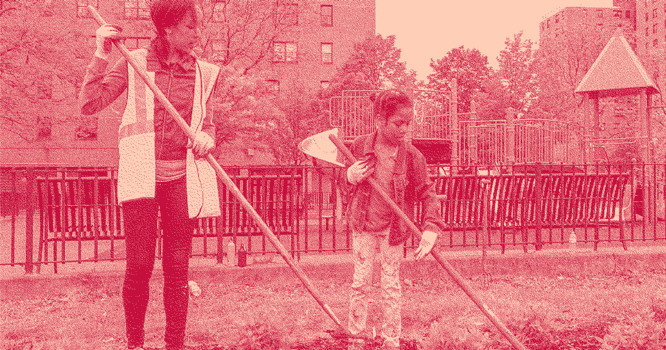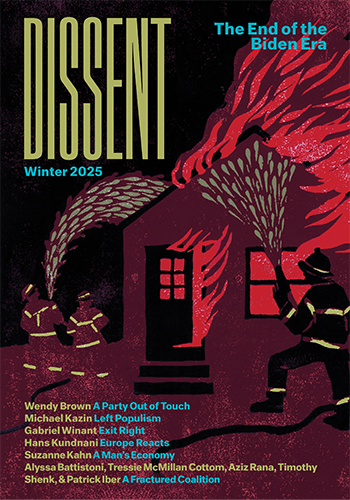The Housing Revolution We Need
The Housing Revolution We Need
A decade after the crash of 2008, a growing movement has thrust our prolonged housing crisis to the center of the national agenda. Could this generation finally make the right to housing a reality?
Introducing the special section of our Fall issue.

Are we on the brink of a revolution in housing policy? In the three-quarters of a century since Franklin Delano Roosevelt promised Americans “the right to a decent home,” the housing market has remained both a cause of America’s racial and economic inequality and a woefully inadequate solution to it. Today, a decade after the financial crash of 2008, even in a period of rapid economic growth, the home-finance and rental markets are failing millions of Americans. But, as in the Depression, a new generation of politicians are putting housing inequality at the center of the national agenda. Congressional candidates ranging from Minnesota’s Ilhan Omar to Hawaii’s Kaniela Ing have called for “Housing for All,” including rent-stabilization programs and a new infusion of federal subsidies for the construction of affordable housing. In New York City, where half of renters are paying more than a third of their income on housing, Alexandria Ocasio-Cortez is calling for an end to subsidies for luxury developments and the redirection of funds to expand housing for low-income and middle-class residents.
Today’s calls for a “right to housing” echo FDR’s language, but promise to overcome the serious limits of the pro-homeownership, anti-renter, bank-friendly policies that are the New Deal’s legacy. Roosevelt’s administration launched an era of homeownership by intervening in a market that had mostly failed working- and middle-class Americans. Over the next several decades, with federal backing, lenders lengthened the terms of mortgages, dramatically reduced down payments, and lowered interest rates. Developers could build new housing at an unprecedented scale, using mortgage-backed securities and tax subsidies. But the right to a decent home, however laudable, was honored in the breach when it came to race. Through the late 1960s, federal housing agencies backed mortgages and loans only to residents of racially homogeneous neighborhoods. Banks refused to lend to African Americans—and in parts of the country Mexican and Asian Americans—on the grounds that their presence devalued properties and jeopardized investments.
Less heralded—but just as consequential—federal housing policy privileged one path to a decent home: ownership. The home mortgage-tax deduction, which dated to 1913, became what political scientist Christopher Howard calls an instrument of the “hidden welfare state,” providing benefits to the middle class and the wealthy at the expense of non-homeowners. Federal housing programs provided a perverse disincentive to developers to build communities with a healthy mix of high-density rental housing and lower density single-family residences.
Despite the best efforts of reformers, the United States put little into the construction of public, affordable housing at a time when cities worldwide greatly expanded their inventory of social housing to meet the needs of the poor. The New Deal’s U.S. Housing Authority was underfunded; it left decisions about the construction of affordable housing to the discretion of localities, which (if they chose to build it at all) shunted it to mostly marginal sites. Even funds through the controversial urban renewal programs, authorized by Congress in 1949 and amended in 1954, largely went to housing and commercial developments intended to attract the middle class to cities, rather than providing decent housing for the poor. Demand for public, subsidized housing in American cities always exceeded supply, a problem that worsened as federal funds for low-income housing dwindled.
By the middle of the twentieth century, the United States had separate and unequal housing markets, a version of what Michael Harrington memorably called “socialism for the rich and free enterprise for the poor.” People of color were largely frozen out of the mainstream, government-regulated mortgage market. If they wanted to buy, they had no choice but to rely on non-conventional loans, including contract buying, with high interest rates, punitive terms, and high foreclosure rates. Otherwise they were left to the whims of landlords, many of them absentee, who charged high rents while milking their properties of most of their value by neglecting maintenance.
The biggest consequence of the dual housing market in the United States was a massive, persistent gap in household wealth between whites and everyone else. For the majority of Americans, few investments have mattered more than the home—their single most significant holding, dwarfing stocks, bonds, savings accounts, and other assets. The notion of real estate as investment is as old as the republic, but beginning with the New Deal, new financial instruments allowed white Americans to reconceive of their homes as potential sources of profit. Many Americans saw the home as tantamount to a stock or bond investment (even if returns on the stock market regularly outpaced the housing market). They used home equity to subsidize their children’s education and as collateral for loans. And eventually, many passed down the value of their homes as inheritances. Renters or homeowners subject to predatory loans and frequent foreclosures, by contrast, had little or nothing to pass on. The resulting wealth gap has been well documented. Between the 1980s and the current decade, the wealth gap between black and white Americans has fluctuated between roughly six to one and seventeen to one.
It seemed for one hopeful moment—in the late 1960s—that the playing fields would even out. Federal fair housing legislation, enacted in 1968, promised to undo decades of discrimination in the real-estate market. The newly created Department of Housing and Urban Development (HUD) seemed poised to make metropolitan housing markets more inclusive.
But the policy prescriptions for overturning entrenched discrimination fell far short of the goal. Fair-housing litigation was costly and relied on well-meaning but often underfunded local civil rights organizations. For their part, real-estate agents and lenders quickly discovered end runs around civil rights laws, most notably the hard-to-document practice of steering racial minorities away from white communities. HUD’s mandate to build affordable housing crashed into the Nixon administration’s hostility to “forced” integration and limped on through bipartisan austerity budgets that devastated urban spending. What remained were federal subsidies for often unscrupulous private developers who took advantage of a swelling interest in market-based solutions to public problems, as Keeanga-Yamahtta Taylor describes in her contribution to this section.
At the bottom tier of housing policy was the vast and growing unregulated rental market. As sociologist Matthew Desmond has powerfully demonstrated, tenants—even those with housing vouchers and modest subsidies—were trapped in an unregulated market characterized by high rents, miserable conditions, stringent leases, and punitive laws that put the interests of landlords before those of tenants. The result—as Desmond’s interview and the accompanying photo-essay illustrate—was a system of vicious insecurity and precarity. Not only were tenants unable to save, they were often unable to even stay in their apartments. Frequent evictions and turnover often led to a cascade of fees and penalties, litigation, poor credit ratings, and even greater financial and housing vulnerability.
If the rental market fell prey to one form of deregulation, the mortgage market fell prey to another. Beginning in the 1970s—as part of a bipartisan wave to restructure the financial sector and unleash credit, ostensibly to empower consumers—the federal government loosened regulations on savings and loan associations and banks. The home financing industry—at the impetus of the administrations of both Bill Clinton and George W. Bush—engaged in the biggest promotion of homeownership in decades. Both presidents pushed for public-private partnerships, with HUD and government-supported financiers like Fannie Mae serving as the mostly silent partners in a rapidly metastasizing mortgage market. As government regulators loosened their control of the mortgage market, they allowed bankers and financiers to develop new tools, including the securitization of mortgages and the expansion of subprime lending. Rates of homeownership rose during this period to record highs—but lenders also pushed high-interest and risky mortgages on people desperate to own their own homes, improve their properties, and ride the elevator of rising home prices. Predatory lenders fanned out over poor and working-class neighborhoods and engaged in reckless profit-seeking at the expense of would-be homeowners.
At the same time, mortgage lenders encouraged speculation. As housing values rose astronomically in the first decade of the twenty-first century (largely fueled by easy credit), would-be investors looked to real estate as a get-rich-quick scheme; ordinary homeowners used home equity to expand their purchasing power after years of wage stagnation. Housing developers—eager to meet the seemingly insatiable demand for new housing—overbuilt. Places like the Central Valley of California, metropolitan Las Vegas, and Miami-Dade County were particularly hard hit by speculative overbuilding. In dense central cities as well as racially diversifying inner-ring suburbs, millions of homeowners lost their properties to foreclosure; millions more found themselves underwater, holding debts greater than the market value of their homes. The 2008 crisis grew from specific economic conditions in turn-of-the-century America, but also from the combination of economic consolidation, political lobbying, and financial regulation and deregulation that had evolved over the previous several decades.
In the decade since the crash, the cycle of predation and profit has taken new form. Major holding companies and hedge funds swept into devastated communities from Barcelona to exurban Los Angeles, gobbling up foreclosed properties for pennies on the dollar, often turning them into pricey rentals. Investors, most infamously Trump advisor Jared Kushner, gobbled up inexpensive townhouse and apartment complexes in racially transitional suburbs, making cosmetic improvements, and marketing them aggressively to credit-poor tenants (many themselves the victims of the housing crash), bilking them with high rents, stiff fees, and punitive leases.
Ten years after the crash, we face an ongoing crisis of housing insecurity. Many major cities both in the United States and worldwide have overbuilt for the wealthy, while starving the working class of affordable housing. While many activists focus on gentrification as the cause of urban housing woes, the problem goes far, far deeper, owing to a profound lack of decent, affordable housing and the market’s utter inability to meet that demand. As Gianpaolo Baiocchi and his colleagues remind us, 39 million households in the United States spend more than 30 percent of their income on rent or a mortgage; 19 million spend more than half of their income on rent. Younger people, as Victor Chen points out, bear a double burden coming of age in an increasingly unequal economy. As they struggle with underemployment, frequent joblessness, and a lack of savings, they face escalating housing costs. The mutually reinforcing cycle of work and housing insecurity worsens economic inequality.
Compounding the problem, as Rachel M. Cohen shows, is the federal government’s abdication of past commitments, even if they were never wholly met, to building inclusionary housing and subsidizing low-income tenants. Trump’s Department of Housing and Urban Development, currently being dismantled by neurosurgeon Ben Carson, has jettisoned both the last remnants of civil rights and fair housing and has committed itself to a policy of “self-sufficiency,” which essentially means letting the poor fend for themselves in a dysfunctional market. Creative litigation may stave off the worst of the Trump administration’s attacks on fair housing, and even achieve some new breakthroughs in combating discrimination. But overcoming the current housing crisis will require a deeper transformation, elements of which can be found in the sorts of experiments that Baiocchi and his colleagues advocate. Their commonsense argument for the decommodification of land and housing draws from a long American history of cooperative living and more recent experiments in mutual aid and shared ownership in places as diverse as Uruguay and Germany. As they note, we might then begin to meet Roosevelt’s compelling, if flawed, vision of a right to decent housing.
Thomas J. Sugrue is professor of history, social and cultural analysis, and public policy at New York University, where he directs the NYU Collaborative on Global Urbanism.




